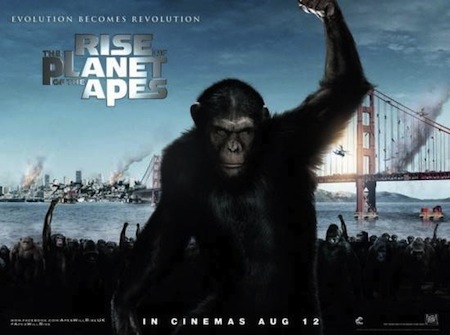
Prison Themes Central to New Planet of the Apes Story

Rise of the Planet of the Apes is the second remake of the original Planet of the Apes movie series. It is an origins story, replacing the Conquest of the Planet of the Apes story which was fourth in the original five part series. Conquest was released in 1972 and depicted a storyline clearly intended to parallel the Black liberation movement that had just peaked in the United $tates at that time, but with an actual successful revolution. Conquest and the final part of the original series, Battle for the Planet of the Apes, presented clearly revolutionary themes. Even the first couple movies of the original series did more to challenge white nationalism than this recent remake. This difference is due to the stage of struggle in the United $tates at the time.
Today, the first movie (released in 1968) is easily dismissed by the oppressor nation as a commentary on the “distant” past of slavery, rather than what were modern social injustices. When that film was redone in 2001, it did not live up to its predecessor’s social relevance. Based on that disappointment, we expected a stronger effort to dilute the origins story for another hollywood blockbuster. Instead, we were pleasantly surprised to find that Rise actually maintained the revolutionary origins story, and even linked it to the modern prison struggle in relevant ways.
This movie probably won’t be making the rounds in too many prisons due to the blatant themes of prisoners educating themselves and building unity to escape their abusive conditions. But there’s nothing to learn from this movie that one couldn’t get easily, and of course more usefully, from picking up any issue of Under Lock & Key.
Rise was pretty formulaic in story and form. It contains lots of fast battle scenes and loud music, and followed the predictable story line with flat characters. There were plenty of quotes from the original movie series thrown in as well as recognizable character names.
The good aspects of Rise were also simple, but surprisingly relevant. The strongest positive message we saw in this film was the need for self-determination and the struggle against integrationism. Caesar, a chimpanzee, and the hero of the story, refuses an opportunity given by his former benefactor to leave prison and return to the humyn world. In a few days or weeks Caesar develops an affinity for his fellow imprisoned apes, which trumps his many years living with humyns. He turns his back to Dr. Rodman and stays in prison to continue building and organizing with fellow apes. This is a very relevant point to the imprisoned population, especially in a day when the oppressed nations have reached high levels of integration into Amerika. With people shuffling in and out of prison and jail, it is easy to choose an Amerikan identity over that of the oppressed. We also see many who work tirelessly to get themselves out of prison, without ever joining the larger prison movement. Caesar is clear that alone apes are weak, but together they can be strong. This is a very simple yet relevant refrain to our current situation in the prison movement today.
An orangutan responds to Caesar’s comments on unity by saying that apes are dumb, not unlike what many prisoners who write MIM(Prisons) say about their peers. The solution to this in the film, and the material origin of apes taking over humyn society, is in a virus produced by a bioengineering project. This allows ape brains to develop intelligence that they never could before. In real life, the imprisoned and oppressed do not face a material disadvantage in intelligence, but are set back by the oppressor’s conditioning through both the carrot and the stick. In real life the ALZ 112 and ALZ 113 viruses from the film are instead Marxism-Leninism-Maoism: the tool that can give the oppressed the intellectual material they need to organize effectively.
As part of his organizing efforts, Caesar allies with a silverback (dominant) chimpanzee and puts him in a position of leading the group in sharing and developing a group consciousness, without the silverback really understanding at first. It was a good lesson in leadership within a United Front and how we might work with those who are recognized as leaders for their dominant roles within the group, but don’t yet possess the leadership skills and revolutionary understanding to lead the oppressed down the road of liberation.
Just like in U.$. prisons, the apes educate each other in secret because they know that they will be targeted for special repression if seen. The interactions between the imprisoned apes and humyn captors is crude, accurately reflecting the basic relations in U.$. prisons for humyns today. In this way, Rise could play a small role in building consciousness among viewers that would make them more likely to be sympathetic of prison resistances such as those organized across California and Georgia in recent months. While the majority of the audience will find itself rooting for the apes while watching this film, in real life most will follow their own self-interests in the situation and root for the state in repressing any group that challenges the status quo.

The role of Buck the gorilla gives us an important lesson in revolutionary suicide. In the final battle scene that takes place on the Golden Gate bridge in San Francisco, he takes a bullet for Caesar just before taking down the last humyns left standing who threatened the lives of other apes in the battle. He recognizes the unique capabilities of both himself and of Caesar and puts the interests of the ape liberation struggle above his own life to guide his actions. At this stage in the struggle we are not engaged in protracted war, but revolutionary sacrifice is still relevant to how we decide to spend our time and organize our lives, and even in peaceful struggles lives are sometimes taken by the oppressor. Buck’s revolutionary suicide is an example of a sacrifice that had to be made in order for the ape struggle to continue.
In the end of the film, Dr. Rodman again plays the role of liberal integrationist asking Caesar to come back and live with him, saying “this is not the way.” Caesar speaks a full phrase for the first time and says “Caesar is home” referring to the population of just-liberated apes taking up residence in the forest. Of course, in real life the consciousness of the oppressed internal semi-colonies leans much more heavily in the direction of integration than Caesar, who has actual biological differences from the humyn species. In the movie, differences between apes and humyns had just begun to weaken, whereas the socially imposed differences between the oppressed and oppressor nations inside the United $tates have eroded over many decades. Even if Caesar tried to integrate, he could never live the lifestyle of a humyn, in contrast to the large proportion of the internal semi-colonies that enjoy the comforts of imperialist exploitation.








